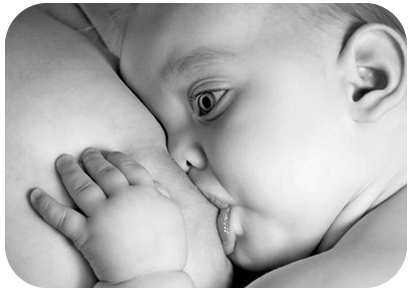Why breastfeed?
Breastfeeding gives your baby a headstart in life because breast milk will meet all his/her nutritional needs. It is the only food he needs from birth till six months of age when the baby starts to wean, i.e. introducing semi-solid food. Some mothers continue to breastfeed their babies even until more than six months of age. Breastfeeding can be continued up to about two years of age if the baby does not suffer from any special medical condition.
 What are the advantages of breastfeeding for my baby?
What are the advantages of breastfeeding for my baby?
Complete Nutrition
The nutrition composition of breast milk is just right and changes to match the needs of your growing baby. There is no need to introduce any other food until your baby is at least six-month-old.  Furthermore, the milk composition also changes during a feed, becoming higher in fat towards the end of a feed. Thus, making the baby feel full and stop suckling. This reduces the likelihood of overfeeding your baby.
Furthermore, the milk composition also changes during a feed, becoming higher in fat towards the end of a feed. Thus, making the baby feel full and stop suckling. This reduces the likelihood of overfeeding your baby.
Reduces Risks of Infections
Breast milk contains colostrum, the early milk produced two to three days after birth by the breast. Colostrum counters risk of infection as it contains high content of immunoglobulin A (IgA) which have protective functions to the gastrointestinal tract of the baby. This helps your baby fight against infections such as diarrhea and also respiratory tract infections.

Reduce Risks of Childhood Diseases
Breastfed babies are less prone to allergies, asthma, eczema, colic, constipation and sudden infant death syndrome. Breast milk are also found to reduce risks of childhood obesity, certain childhood malignancies and mal-aligned teeth of the child.
Development of Cognitive Function
Research has shown evidence that breast milk enhances the development of your child’s cognitive function, i.e. intelligence and learning abilities. These cognitive developmental benefits increase with the duration of breastfeeding.
Comfort and Mother-Child Bonding
As you breastfeed your baby, he/she will feel comfortable and secured as the child feeds from your breast.

What are the benefits of breastfeeding for me?
- Child Spacing – Breastfeeding delays the return of menstruation and hence can be used as a method for family planning if you breastfeed fully.
- Anti-Cancer – Breastfeeding is evidently found to provide protection against breast cancer as well as ovarian cancer.
- Contraction of Womb – When your baby starts to suckle, contraction of the womb occurs. Hence, breastfeeding speeds up the contraction of your womb to its pre-pregnancy size.
- Convenience – Aside from cleaning and washing your nipples before you breastfeed, there is no need to spend time and effort in sterilizing feeding bottles while you are breastfeeding your child.
- Cost Saving – There is natural production of milk which contains the perfect formula for your child. You will not need to buy milk formulas.
- Lose Weight – Calories are used up when you breastfeed. Thus, if you maintain a sensible and balanced diet, you will be able to lose the fat stored during the period of pregnancy.
How do I prepare myself for breastfeeding?
As a rule of thumb, you should be prepared physically, mentally and emotionally.

Physical Preparation
- Maintain a healthy diet during pregnancy
- By the seventh month into pregnancy, purchase maternity bras of good quality and support
- Consult your doctor for breast examination to check if your nipples are suitable for breastfeeding
- Prepare your wardrobe for breastfeeding, such as loose blouses or special maternity-wear that aids in breastfeeding

Mental and Emotional Preparation
- Acquire more information about breastfeeding, such as reading materials
- Plan ahead regarding the duration you want to breastfeed your child
- Discuss with your husband about breastfeeding and win his support
- Attend educational talks about breastfeeding with your husband
- Be confident about your decision to breastfeed your child. Have a positive attitude and be optimistic that you will succeed
How do I start breastfeeding?
Firstly, wash your hands thoroughly with soap and water. Wet a small towel or clean handkerchief and clean your nipples and areola daily or every time before you let your baby suckle.

Sit or lie down in a position you find most comfortable. Hold your baby with his head well-supported and bring him/her to your breast. There are different positions in which you can breastfeed your baby in, such as sitting up straight with or without back support, or lying on one side so that your baby can also lie down on the bed while suckling.

Hold up your breast and touch your baby’s cheek with your nipple and by nature he should turn his/her head towards your breast. When your baby’s mouth is opened side, pull him/her close so that your areola is in his mouth as much as possible. Your baby’s lips will flatten and his/her tongue will be cupped beneath your nipple. And once again, naturally, your baby will instinctively start to suckle. This is known as “latching onâ€.
Allow your baby to suckle as long as possible. When your baby is full or satisfied, he/or she should naturally detach from your breast. At times when you need to detach you baby, just insert your little finger into your baby’s mouth and then remove him/her gently from your breast. There is no need to burp your baby unless he/she has been crying a lot.

